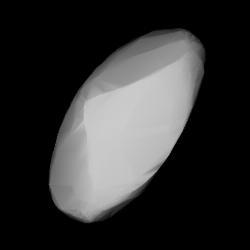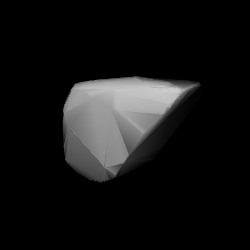Related Research Articles

2839 Annette is a bright Flora asteroid from the inner regions of the asteroid belt. It was discovered on 5 October 1929, by American astronomer Clyde Tombaugh at Lowell Observatory during his search for Pluto. The presumed S-type asteroid has a rotation period of 10.5 hours and measures approximately 5 kilometers in diameter. It was named after the discoverer's daughter.
2033 Basilea, provisional designation 1973 CA, is a stony asteroid from the inner regions of the asteroid belt, approximately 6 kilometers in diameter. It was discovered on 6 February 1973, by astronomer Paul Wild at the Zimmerwald Observatory near Bern, Switzerland. The asteroid was named for the Swiss city of Basel.
2034 Bernoulli, provisional designation 1973 EE, is a stony asteroid from the inner regions of the asteroid belt, approximately 9 kilometers in diameter.

2490 Bussolini is an Eunomia asteroid from the central region of the asteroid belt, approximately 12 kilometers in diameter. It was discovered on 3 January 1976, by staff members of the Félix Aguilar Observatory at El Leoncito Complex in Argentina. The asteroid was named after Argentine Jesuit physicist Juan Bussolini.
1707 Chantal, provisional designation 1932 RL, is a stony background asteroid from the Florian region in the inner asteroid belt, approximately 7.5 kilometers in diameter. It was discovered on 8 September 1932, by astronomer Eugène Delporte at the Royal Observatory of Belgium in Uccle. The S-type asteroid has a rotation period of at least 10 hours. It was named for Chantal, the niece of Belgian astronomer Georges Roland.
2440 Educatio is a Florian asteroid from the inner regions of the asteroid belt, approximately 6.6 kilometers in diameter. The possibly elongated S-type asteroid has an exceptionally long rotation period of 1561 hours and is one of the slowest rotators known to exist. It was discovered on 7 November 1978, by American astronomers Eleanor Helin and Schelte Bus at the Palomar Observatory in California, and later named "Educatio", the Latin word for Education.
1771 Makover, provisional designation 1968 BD, is a carbonaceous asteroid from the outer region of the asteroid belt, approximately 50 kilometers in diameter.
2056 Nancy, provisional designation A909 TB, is a stony background asteroid from the inner regions of the asteroid belt, approximately 10 kilometers in diameter. It was discovered on 15 October 1909, by German astronomer Joseph Helffrich at Heidelberg Observatory in southwest Germany. The S-type asteroid has a tentative rotation period of 15.0 hours. It was named for Nancy Marsden, wife of British astronomer Brian G. Marsden.
7476 Ogilsbie, provisional designation 1993 GE, is a carbonaceous asteroid from the outer region of the asteroid belt, approximately 20 kilometers in diameter. It was discovered by American astronomer Timothy Spahr at the U.S. Catalina Station in Tucson, Arizona, on 14 April 1993.
1990 Pilcher, provisional designation 1956 EE, is a stony background asteroid from the Florian region of the inner asteroid belt, approximately 7 kilometers in diameter. It was discovered on 9 March 1956, by German astronomer Karl Reinmuth at the Heidelberg-Königstuhl State Observatory in Heidelberg, Germany. In 1982, it was named by the MPC for American physicist and photometrist Frederick Pilcher. The S-type asteroid has a short rotation period of 2.8 hours.

2384 Schulhof (prov. designation: 1943 EC1) is a mid-sized asteroid and the namesake of the Schulhof family, located in the Eunomian region of the intermediate asteroid belt. It was discovered on 2 March 1943, by French astronomer Marguerite Laugier at Nice Observatory in southeastern France. The asteroid was later named after Hungarian astronomer Lipót Schulhof. The presumed S-type asteroid has a short rotation period of 3.3 hours and measures approximately 12 kilometers (7.5 miles) in diameter.

1854 Skvortsov (prov. designation: 1968 UE1) is a stony background asteroid and relatively slow rotator from the middle region of the asteroid belt, approximately 9 kilometers in diameter. It was discovered on 22 October 1968, by Russian astronomer Tamara Smirnova at the Crimean Astrophysical Observatory in Nauchnyj on the Crimean peninsula. It is named after astronomer Evgenii Skvortsov.
1807 Slovakia, provisional designation 1971 QA, is a stony asteroid and slow rotator from the inner regions of the asteroid belt, approximately 9 kilometers in diameter. It was discovered on 20 August 1971, by Slovak astronomer Milan Antal at Skalnaté pleso Observatory in the High Tatras mountains of Slovakia and named after the Slovak Republic.
1397 Umtata, provisional designation 1936 PG, is an asteroid from the background population of the asteroid belt's central region, approximately 21 kilometers in diameter. It was discovered by South-African astronomer Cyril Jackson at the Union Observatory in Johannesburg on 9 August 1936. The asteroid was named after the South-African town of Mthatha, formerly known as Umtata.
3669 Vertinskij, provisional designation 1982 UO7, is a stony Florian asteroid from the inner regions of the asteroid belt, approximately 6.5 kilometers (4 miles) in diameter. It was discovered on 21 October 1982, by Soviet astronomer Lyudmila Karachkina at the Crimean Astrophysical Observatory in Nauchnij, on the Crimean peninsula. The S-type asteroid was named for Russian artist Alexander Vertinsky.

1704 Wachmann, provisional designation A924 EE, is a stony asteroid from the inner regions of the asteroid belt, approximately 7 kilometers in diameter. It was discovered by German astronomer Karl Reinmuth at Heidelberg Observatory on 7 March 1924. It was later named after astronomer Arno Wachmann.
1530 Rantaseppä, provisional designation 1938 SG, is a stony Florian asteroid from the inner regions of the asteroid belt, approximately 5 kilometers in diameter. Discovered by Yrjö Väisälä at Turku Observatory in 1938, it was later named after Finnish astronomer Hilkka Rantaseppä-Helenius.
2613 Plzeň, provisional designation 1979 QE, is an asteroid from the outer region of the asteroid belt, approximately 28 kilometers in diameter. It was discovered on 30 August 1979, by Czech astronomer Ladislav Brožek at the South Bohemian Kleť Observatory in the Czech Republic. It was later named for the Czech city of Plzeň.

1542 Schalén, provisional designation 1941 QE, is a background asteroid from the outer region of the asteroid belt, approximately 45 kilometers in diameter. It was discovered on 26 August 1941, by Finnish astronomer Yrjö Väisälä at Turku Observatory in Southwest Finland. The dark D-type asteroid was later named after Swedish astronomer Karl Schalén.
1887 Virton, provisional designation 1950 TD, is a stony Eoan asteroid from the outer region of the asteroid belt, approximately 21 kilometers in diameter. It was discovered by Belgian astronomer Sylvain Arend at the Royal Observatory of Belgium in Uccle on 5 October 1950, and named after the Belgian town of Virton.
References
- 1 2 3 4 "JPL Small-Body Database Browser: 1918 Aiguillon (1968 UA)" (2017-05-05 last obs.). Jet Propulsion Laboratory . Retrieved 1 July 2017.
- 1 2 3 Schmadel, Lutz D. (2007). "(1918) Aiguillon". Dictionary of Minor Planet Names – (1918) Aiguillon. Springer Berlin Heidelberg. p. 154. doi:10.1007/978-3-540-29925-7_1919. ISBN 978-3-540-00238-3.
- 1 2 3 Masiero, Joseph R.; Grav, T.; Mainzer, A. K.; Nugent, C. R.; Bauer, J. M.; Stevenson, R.; et al. (August 2014). "Main-belt Asteroids with WISE/NEOWISE: Near-infrared Albedos". The Astrophysical Journal. 791 (2): 11. arXiv: 1406.6645 . Bibcode:2014ApJ...791..121M. doi:10.1088/0004-637X/791/2/121 . Retrieved 10 December 2016.
- 1 2 "Absolute Magnitude (H)". NASA/JPL. Archived from the original on 2 March 2001. Retrieved 2 January 2016.
- 1 2 "1918 Aiguillon (1968 UA)". Minor Planet Center. Retrieved 10 December 2016.
- ↑ "LCDB Data for (1918) Aiguillon". Asteroid Lightcurve Database (LCDB). Retrieved 11 April 2017.
- ↑ "MPC/MPO/MPS Archive". Minor Planet Center. Retrieved 10 December 2016.